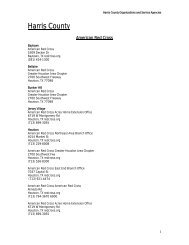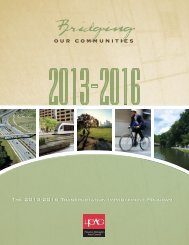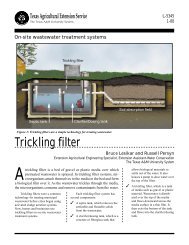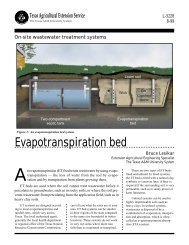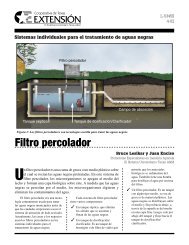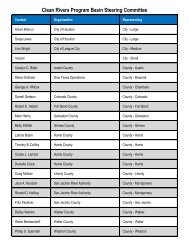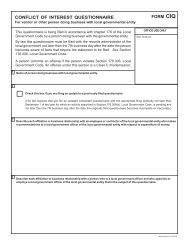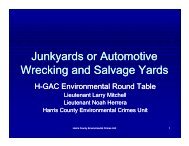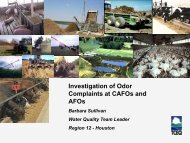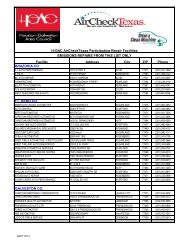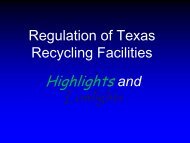TCEQ Outdoor Burning Rules - Houston-Galveston Area Council
TCEQ Outdoor Burning Rules - Houston-Galveston Area Council
TCEQ Outdoor Burning Rules - Houston-Galveston Area Council
You also want an ePaper? Increase the reach of your titles
YUMPU automatically turns print PDFs into web optimized ePapers that Google loves.
<strong>TCEQ</strong> <strong>Outdoor</strong> <strong>Burning</strong> <strong>Rules</strong><br />
30 TAC Chapter 111 30 TAC Chapter 106<br />
Subchapter B Subchapter V<br />
§111.201 - §111.221 Permit-by-Rule §106.496<br />
<strong>TCEQ</strong> <strong>Houston</strong> Regional Office:<br />
Peter Bolds Faye Liu<br />
Sr. Environmental Investigator Program Specialist<br />
Air Section Office of Public Assistance<br />
713/767-3730 713/767-3726<br />
pbolds@tceq.state.tx.us state tx fliu@tceq.state.tx.us<br />
tx us<br />
1
What is <strong>Outdoor</strong> <strong>Burning</strong>?<br />
<strong>Outdoor</strong> <strong>Burning</strong>, or Open <strong>Burning</strong>, is the combustion<br />
of any type of material in an open fire or in an outdoor<br />
container without providing for the control of<br />
combustion or the control of emissions from the<br />
combustion.<br />
Exposure to elevated levels of particulate matter and<br />
combustion products alone can cause adverse health<br />
affects such as eye and respiratory irritation. Sensitive<br />
individuals such as children, individuals with<br />
respiratory (asthma, chronic obstructive pulmonary<br />
disease, or emphysema) or cardiac conditions, and<br />
pregnant women can be at risk of more significant<br />
adverse health effects.<br />
2
Definitions<br />
Landclearing Operation - uprooting, cutting or clearing<br />
of vegetation for the purpose p of construction of<br />
buildings, rights-of-way, or to enhance property value,<br />
access or production<br />
Practical Alternative - an economically,<br />
technologically, ecologically and logistically viable<br />
option<br />
Prescribed Burn - the controlled application of fire to<br />
naturally-occurring vegetation under specified<br />
conditions and confined to a predetermined area<br />
3
Definitions - con’t.<br />
Nuisance - §101.4<br />
No person shall discharge from any source whatsoever<br />
one or more air contaminants or combinations thereof,<br />
in such concentration and of such duration as are or<br />
may tend to be injurious to or to adversely affect human<br />
health or welfare, animal life, vegetation, or property,<br />
p or as to interfere with the normal use and enjoyment of<br />
animal life, vegetation, or property. Effective May 6, 1979<br />
4
Summary of the Rule<br />
<strong>Outdoor</strong> burning is prohibited in the state t of<br />
Texas - §111.201<br />
Exceptions allowed - Authorization to burn is<br />
ONLY given by <strong>TCEQ</strong>!<br />
Must meet conditions when burning is allowed<br />
Special authorization if a situation does not fit<br />
an exception<br />
6
Exceptions to the Rule<br />
Applicable local governmental ordinances,<br />
regulations or orders<br />
Individual county burn bans<br />
Ordinances that ban burning altogether<br />
Ordinances that allow burning consistent with Texas<br />
Clean Air Act (TCAA)<br />
7
Exceptions to the Rule<br />
Firefighter Training<br />
Fires for Recreation, Ceremony, Cooking or<br />
Warmth<br />
Fires for Disposal or Landclearing<br />
Prescribed Burns<br />
Pipeline e Breaks and Oil Spills<br />
Other Situations<br />
8
9<br />
Exceptions to the Rule<br />
Firefighter Training - §111.205<br />
Request must be in writing to <strong>TCEQ</strong><br />
Authorized if notice of denial from <strong>TCEQ</strong> is not<br />
received within 10 working days<br />
Training frequency:<br />
At least weekly - submit annual written notification<br />
Less than weekly - submit annual written<br />
notification, 24-hour advance notice<br />
May M not cause a nuisance or traffic hazard<br />
General requirements for allowable outdoor<br />
burning do not apply
General Requirements for Allowable<br />
<strong>Burning</strong> - §111.219<br />
Notify Texas Forest Service prior to prescribed<br />
or controlled burning for forest management<br />
<strong>Burning</strong> i must be outside corporate limits it of<br />
city/town unless incorporated city/town has<br />
burning ordinance<br />
Burn only when weather conditions are such that<br />
smoke and pollutants will not cause adverse<br />
affects<br />
Post flag person<br />
1
General Requirements for Allowable<br />
<strong>Burning</strong> - §111.219<br />
Distance requirement<br />
Burn times<br />
Presence of responsible party<br />
Proper meteorological eeooogc conditions<br />
o Prevent nuisance or traffic hazard<br />
2
General Requirements for Allowable<br />
<strong>Burning</strong> - §111.219<br />
Materials not allowed to be burned:<br />
electrical insulation<br />
treated lumber<br />
plastics<br />
non-wood construction/demolition materials<br />
heavy oils<br />
asphaltic p materials<br />
potentially explosive materials<br />
chemical wastes<br />
items containing natural or synthetic rubber<br />
3
Exceptions to the Rule<br />
Recreation, e Ceremony, e Cooking and Warmth -<br />
§111.207<br />
Recreational or ceremonial purposes, noncommercial<br />
preparation p of food, or supplying<br />
warmth<br />
May not cause a nuisance or traffic hazard<br />
General requirements for allowable outdoor<br />
burning do not apply -Exception: must comply<br />
with list of materials not allowed<br />
to beburned<br />
17
Exceptions to the Rule<br />
Fires for Disposal or Landclearing<br />
Six Most Common Categories<br />
Domestic waste<br />
Diseased animal carcasses<br />
Animal i l remains burning by a veterinarian<br />
i<br />
Maintenance e or landclearing<br />
Crop residues<br />
Brush, trees, etc., off-site<br />
20
Fires for Disposal or Landclearing<br />
Six Most Common Categories<br />
Domestic Waste - §111.209(1)<br />
Household trash and rubbish<br />
Waste from a private residence<br />
Waste must be burned on property where<br />
generated<br />
May not cause a nuisance or traffic hazard<br />
21
Fires for Disposal or Landclearing<br />
Six Most Common Categories<br />
Diseased Animal Carcasses - §111.209(2)<br />
Controlling gthe spread of disease<br />
May not cause a nuisance or traffic hazard<br />
<strong>TCEQ</strong> Regulatory Guidance - Disposal of<br />
Domestic or Exotic Livestock Carcasses,<br />
RG-419, November 2004 - Exhibit A<br />
23
Fires for Disposal or Landclearing<br />
Six Most Common Categories<br />
Animal Remains <strong>Burning</strong> by a Veterinarian -<br />
§111.209(3)<br />
Senate Bill 216, 78th Texas Legislative Session, 2003<br />
Must comply with Texas Occupation Code §801.361 -<br />
Disposal of Animal Remains (Exhibit B):<br />
May burn/bury animal remains and related medical<br />
wastes in vet’s care on his/her property<br />
Location of property<br />
<strong>TCEQ</strong> outdoor burning and nuisance rules do not apply<br />
25
Fires for Disposal or Landclearing<br />
Six Most Common Categories<br />
Animal Remains <strong>Burning</strong> by a Veterinarian -<br />
§111.209(3)<br />
30 TAC Chapter 106, Subchapter V, §106.494 -<br />
Pathological Waste Incinerators (Exhibit C)<br />
30 TAC Chapter 330, Subchapter A, §330.4(y) through<br />
(aa) -Permit Requirements (Exhibit D)<br />
30 TAC 330, Subchapter E, §330.75 - Animal<br />
Crematory Facility (Exhibit E)<br />
26
Fires for Disposal or Landclearing<br />
Six Most Common Categories<br />
On-site Maintenance or Landclearing -§111.209(4)<br />
27<br />
On-site burning of trees, brush, plant growth for<br />
right-of-way maintenance, landclearing<br />
operations, maintenance along water canals<br />
General requirements for allowable outdoor<br />
burning apply<br />
Sensitive receptors
Fires for Disposal or Landclearing<br />
Six Most Common Categories<br />
Crop Residues - §111.209(5)<br />
Agricultural management<br />
General requirements for allowable outdoor<br />
burning apply<br />
Sensitive receptors<br />
9
Fires for Disposal or Landclearing<br />
Six Most Common Categories<br />
Brush, Trees, etc., Off-site By County or<br />
Municipal Governments - §111.209(6)<br />
Local lgovernments may request site and burn approval<br />
from <strong>TCEQ</strong><br />
Authorized i donly when no practical alternative ti exists<br />
Burn must occur at a site owned by local government<br />
General requirements for allowable outdoor burning<br />
apply<br />
31
Exceptions to the Rule<br />
Prescribed Burns<br />
Forest, Range, etc. - §111.211(1)<br />
32<br />
Used to manage forests, rangeland, wildland, and<br />
wildlife<br />
General requirements for allowable outdoor burning<br />
apply<br />
Sensitive receptors must not be negatively affected<br />
Notification to <strong>TCEQ</strong> should be made when<br />
possible, but not required
Exceptions to the Rule<br />
Prescribed Burns<br />
Coastal Salt-marsh Management -§111.211(2)<br />
Allowed in 14 counties:<br />
33<br />
Aransas Jefferson<br />
Brazoria i Kleberg<br />
Calhoun Matagorda<br />
Chambers Nueces<br />
<strong>Galveston</strong> Orange<br />
Harris Refugio<br />
Jackson San Patricio
Exceptions to the Rule<br />
Prescribed Burns<br />
Coastal Salt-marsh Management -§111.211(2)<br />
Register and identify land where burning will occur -<br />
must be received by <strong>TCEQ</strong> 15 days before burning<br />
takes place<br />
Verbal or written notification must be made prior to<br />
burning; include specific information<br />
General requirements for allowable outdoor burning<br />
apply<br />
4
Exceptions to the Rule<br />
Hydrocarbon <strong>Burning</strong> - §111.213<br />
For pipeline breaks and oil spills - the event may<br />
require notification to <strong>TCEQ</strong><br />
<strong>TCEQ</strong> determines whether burning is necessary to<br />
protect the public welfare<br />
Sampling p g and monitoring may be required<br />
General requirements for allowable outdoor burning do<br />
not apply<br />
38
Exceptions to the Rule<br />
Other Situations - §111.215<br />
Requires written approval from <strong>TCEQ</strong><br />
When no practical alternative exists<br />
May not cause or contribute to a nuisance or<br />
traffic hazard<br />
May not cause or contribute to a violation of a<br />
primary or secondary NAAQS<br />
Authorization can be revoked<br />
39
Exceptions to the Rule<br />
Responsibility for Consequences of <strong>Outdoor</strong><br />
<strong>Burning</strong> - §111.221<br />
<strong>Burning</strong> Authorization does not exempt or excuse:<br />
From consequences, damages, injuries resulting from<br />
the burning, including nuisance<br />
From complying with all other applicable laws,<br />
ordinances, regulations and orders of governmental<br />
agencies having jurisdiction<br />
40
Practical Alternatives to <strong>Burning</strong><br />
“An economically, technologically, ecologically<br />
and logistically viable option”<br />
Recycling<br />
Composting<br />
Mechanical chipping or mulching<br />
Logging<br />
Landfills<br />
Air curtain incinerators i (30 TAC Chapter 106,<br />
Subchapter V - Thermal Control Devices,<br />
Rule §106.496) - Exhibit F<br />
41
Air Curtain Incinerators<br />
CONTROLLED BURNING<br />
Trench h<strong>Burning</strong> &Firebox <strong>Burning</strong><br />
“An incinerator that operates by forcefully<br />
f projecting a curtain of air across an open chamber<br />
in which combustion occurs”<br />
Landclearing<br />
Right-of-way f maintenance<br />
Emergency g yclean-up operations<br />
Non-commercial industrial sites<br />
Municipal solid waste sites<br />
42
Air Curtain Incinerators<br />
CONTROLLED BURNING<br />
Trench <strong>Burning</strong> & Firebox <strong>Burning</strong><br />
§106.496 PBR Conditions (effective 6/30/04)<br />
MAJOR CHANGE - can locate permanent ACIs at<br />
landfills to burn trees, brush, clean lumber generated<br />
on-or off-site<br />
Require air registration and re-registration<br />
Emergency g yclean-up operations do not require<br />
registration<br />
ACIs at landfills also require a separate MSW<br />
authorization<br />
43
Air Curtain Incinerators<br />
CONTROLLED BURNING<br />
Trench <strong>Burning</strong> & Firebox <strong>Burning</strong><br />
§106.496 PBR Conditions - con’t<br />
t.<br />
Distance requirements - minimum 300 feet<br />
Portable facility -180 consecutive days or 600<br />
hours<br />
Permanent facility - 600 hours in any rolling 12-<br />
month period<br />
May process materials for municipal solid waste or<br />
non-commercial industrial sites only<br />
ACI must be equipped with a run-time<br />
meter<br />
44
Air Curtain Incinerators<br />
CONTROLLED BURNING<br />
Trench <strong>Burning</strong> & Firebox <strong>Burning</strong><br />
§106.496 PBR Conditions - con’t.<br />
Presence of operator<br />
Burn times<br />
Material stacking<br />
45<br />
Visible Emissions<br />
Ash disposal<br />
Buried on-site - must deed-record<br />
Sent to a Type I landfill<br />
Beneficial usage, if approved
Air Curtain Incinerators<br />
CONTROLLED BURNING<br />
Trench h<strong>Burning</strong> &Firebox <strong>Burning</strong><br />
§106.496 PBR Conditions - con’t<br />
t.<br />
Maintain records to demonstrate compliance<br />
Not exempt from:<br />
Local regulations, requirements, authorizations<br />
Other state air regulations<br />
Any state water authorizations<br />
Copy of PBR and operating instructions must be<br />
kept at burn site and made available upon<br />
request<br />
6
47<br />
Air Curtain Incinerators<br />
CONTROLLED BURNING<br />
Trench <strong>Burning</strong><br />
“An ACI operation using a trench and air<br />
manifold system”<br />
Trench (below-ground ACIs) at landfill must be<br />
located in undisturbed soil<br />
Trench dimensions: 12' W x 35' L x 10' D<br />
Ash may be buried in trench - must be deedrecorded
Air Curtain Incinerators<br />
CONTROLLED BURNING<br />
Firebox <strong>Burning</strong><br />
“An ACI operation using a manufactured aboveground<br />
container and blower system”<br />
Facilities equipped with refractory walls and<br />
above-fire air supply -750 hours operation in any<br />
rolling 12-month period<br />
Firebox dimensions: 8' W x 35' L x 6' D<br />
(interior)<br />
1
What Do You Do Now?<br />
Receive a complaint<br />
Investigate i and collect evidence<br />
Determine if rules have been violated<br />
Document evidence the way you normally would<br />
Handle like any other violation<br />
55
What Gives You the Authority?<br />
Texas Water Code<br />
Chapter 7 - Enforcement<br />
§ 7.1777 - Violations of Clean Air Act<br />
(a) Elements<br />
(1) A Person<br />
(2) intentionally or knowingly, with respect<br />
to conduct, violates:<br />
(3) an order, permit, or exemption issued or<br />
a rule adopted under Chapter 382, Health &<br />
Safety Code<br />
56
What Gives You the Authority?<br />
Texas Health & Safety Code<br />
Chapter 382 - Clean Air Act<br />
§382.002 - Policy and Purpose<br />
(b) It is intended d that t this chapter be vigorously<br />
enforced and that violations of this chapter or<br />
any rule or order of the Texas Commission on<br />
Environmental Quality result in expeditious<br />
initiation of enforcement actions as provided by<br />
this chapter<br />
57
What Gives You the Authority?<br />
Texas Commission on Environmental Quality<br />
Regulations<br />
Title 30 - Texas Administrative Code<br />
58



